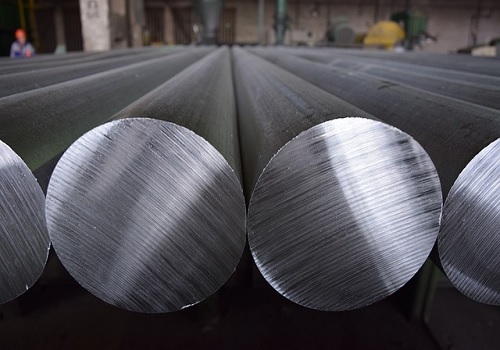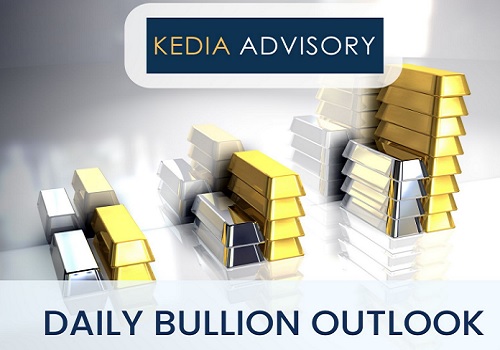Gold trading range for the day is 70410-71690 - Kedia Advisory

Gold
Gold exhibited marginal gains of 0.03% yesterday, settling at 71050, as investors remained focused on deciphering the Federal Reserve's monetary policy stance in light of recent economic indicators. While durable goods orders slightly exceeded expectations in March, the S&P PMI data suggested a deceleration in the growth of the US private sector, adding to the uncertainty surrounding the Fed's future rate decisions. Market attention now turns to forthcoming releases of the advance GDP estimate and PCE inflation reading later in the week, seen as crucial in determining the trajectory of Fed interest rate adjustments. Previously, a hawkish tone from the Fed coupled with a rise in prices had tempered expectations for rate cuts, dampening demand for non-yielding assets like gold. Additionally, the easing of tensions in the Middle East diverted investors towards riskier investments, further challenging gold's appeal. Swiss gold export data for March revealed a decline from February levels, attributed to lower deliveries to key markets like India and Turkey, despite increased shipments to China and Hong Kong. Indian demand softened as customers grappled with the abrupt surge in gold prices, prompting local dealers to offer discounts in a bid to stimulate demand during the wedding season. Technically, the gold market experienced short covering, with open interest decreasing by 0.5% to settle at 19360, accompanied by a price increase of 21 rupees. Presently, gold finds support at 70730, with potential downside to 70410, while resistance levels are observed at 71370, with a breakthrough potentially leading to a test of 71690.
Trading Ideas:
* Gold trading range for the day is 70410-71690.
* Gold stabilized as investors continued to evaluate the Fed's monetary policy outlook
* Durable goods orders slightly beat expectations in March
* US PMI data pointed to a slowing growth in the country's private sector.
Silver
Silver prices experienced a modest decline of -0.22% yesterday, settling at 80,497, as risk premiums associated with tensions in the Middle East eased. Investor attention shifted towards upcoming U.S. economic data releases, which could provide insights into the Federal Reserve's future interest rate decisions. Chicago Federal Reserve President Austan Goolsbee's remarks highlighted concerns about stalled progress in reducing inflation, aligning with recent indications from Fed officials suggesting no immediate urgency for rate cuts. Market sentiment now anticipates the first Fed rate cut to potentially occur in September. U.S. business activity showed signs of cooling in April, accompanied by a slight easing in inflation rates despite sharp rises in input prices, potentially indicating some relief ahead as the Fed monitors economic indicators. Meanwhile, the European Central Bank, according to Bundesbank President Joachim Nagel, awaits convincing evidence of inflation heading towards its 2% target before considering interest rate cuts. Eurozone business activity expanded at its fastest pace in nearly a year, primarily driven by a recovery in the services sector. From a technical standpoint, the silver market observed long liquidation, evidenced by a drop in open interest by -7.15% to settle at 15,526. Despite a significant decline in prices by -181 rupees, silver found support at 80,155, with further downside potential towards 79,815. Conversely, resistance is anticipated at 80,945, and a break above could lead to a test of 81,395. Traders should remain vigilant, monitoring economic data releases and central bank statements for potential shifts in market sentiment and price movements.
Trading Ideas:
* Silver trading range for the day is 79815-81395.
* Silver dropped as risk premiums over tensions in the Middle East eased
* Fed’s Goolsbee said progress on bringing down inflation has "stalled" this year
* U.S. business activity cooled in April, while rates of inflation eased slightly
Crude oil
Crude oil experienced a modest decline of -0.56% yesterday, settling at 6889, as investor concerns regarding conflict in the Middle East eased. Despite this, the market found some support from unexpected developments, including a notable decrease in U.S. crude stocks and a downturn in business activity in the world's largest oil consumer. The Energy Information Administration (EIA) reported a surprising drop of 6.4 million barrels in U.S. crude inventories, far surpassing expectations of a 825,000-barrel rise. Additionally, gasoline stockpiles decreased by 600,000 barrels, while distillate inventories rose slightly. These unexpected figures prompted a turnaround in U.S. crude futures, which edged up by 12 cents following the EIA's data release. Gasoline futures also saw a positive turn, climbing by 0.5%. The unexpected drawdown in crude stocks contrasted with market expectations and interrupted two consecutive weeks of inventory increases. This development highlights the unpredictability of oil markets and the potential influence of geopolitical tensions on supply dynamics. Technically, the crude oil market witnessed fresh selling pressure, with open interest increasing by 5.74% to settle at 5326, accompanied by a price decrease of -39 rupees. Presently, crude oil finds support at 6853, with potential downside to 6818, while resistance levels are observed at 6951, with a breakthrough potentially leading to a test of 7014. Amidst shifting geopolitical dynamics and supply-side factors, crude oil remains subject to volatility, with investors closely monitoring inventory data and geopolitical developments for insights into price movements.
Trading Ideas:
* Crudeoil trading range for the day is 6818-7014.
* Crude oil dropped as investors dialled down concerns over conflict in the Middle East.
* Goldman Sachs sees $90 per barrel ceiling on Brent
* U.S. business activity cooled to 4-month low in April
Natural gas
Natural gas prices faced significant downward pressure yesterday, settling at 168 with a decline of -3.11%. The primary driver behind this downturn was forecasts for mild weather, which led to reduced demand for gas for heating purposes. Throughout the year, natural gas prices have endured a decrease of approximately 30%, largely influenced by mild weather conditions and above-normal stockpiles. Financial firm LSEG forecasts a decrease in gas demand in the Lower 48 states, including exports, with expectations to fall to 93.1 billion cubic feet per day (bcfd) next week from 97.8 bcfd this week. Meanwhile, LNG feedgas was on the rise, reaching nearly a three-week high at 12.9 bcfd, fueled by increased gas flow to Freeport LNG. Gas output in the Lower 48 U.S. states has dwindled, averaging 96.8 bcfd in April compared to 100.8 bcfd in March, and down significantly from the monthly record of 105.6 bcfd in December 2023. This decline in production can be attributed to energy firms such as EQT and Chesapeake Energy delaying well completions and reducing drilling activities in response to low prices earlier in the year. From a technical perspective, the market observed fresh selling pressure, as evidenced by a notable increase in open interest by 55.25% to settle at 31,934. Despite the decrease in prices by -5.4 rupees, natural gas found support at 164.3, with potential further downside towards 160.6. On the upside, resistance is anticipated at 174.5, with a break above potentially leading to a test of 181. Traders should remain cautious, monitoring weather forecasts and production trends for potential shifts in market dynamics.
Trading Ideas:
* Naturalgas trading range for the day is 160.6-181.
* Natural gas fell pressured by forecasts for mild weather leading to lower gas demand for heating.
* LSEG predicts gas demand in Lower 48 states to fall to 93.1 billion cubic feet per day next week
* Gas output in Lower 48 states fell to an average of 96.8 billion cubic feet per day in April from 100.8 billion in March.
Copper
Copper prices saw a modest increase of 0.54% yesterday, settling at 846.05, buoyed by ongoing supply-side issues and shifting market dynamics. The closure of Cobre Panama, one of the world's largest copper mines, since December has contributed to a deficit in global copper concentrate supply, adding support to prices. Furthermore, recent prohibitions on Russian production of aluminum, copper, and nickel by the US and the UK have further tightened supply conditions. However, the rally in copper prices led to some demand destruction in China, while higher inventories prompted investors to unload positions and secure profits. Nonetheless, copper prices found support from a weakening US dollar, as cooling business activity in April supported a dovish outlook on Federal Reserve monetary policy. Chilean President Gabriel Boric's expectation of slow production growth at state-run miner Codelco this year, coupled with optimistic projections for copper prices, added to the bullish sentiment. Additionally, Trafigura's forecast of increased copper consumption in sectors like electric vehicles, power infrastructure, AI, and automation provided further support to prices. In terms of production data, China's copper cathode output demonstrated strength, exceeding expectations and showing significant year-on-year growth. The robust performance in copper production in China, a key player in the global copper market, contributed to market sentiment. Technically, the copper market witnessed fresh buying, with open interest increasing by 12.7% to settle at 5094, accompanied by a price uptick of 4.55 rupees. Presently, copper finds support at 843.8, with potential downside to 841.4, while resistance levels are observed at 849, with a breakthrough potentially leading to a test of 851.8.
Trading Ideas:
* Copper trading range for the day is 841.4-851.8.
* Copper climbed as supply-side issues continued to support prices.
* Cobre Panama, was forced to stop operations in December, leading to a deficit in the global supply of copper concentrate this year.
* Copper prices benefited from a pullback in the dollar as US business activity cooled in April
Zinc
Zinc prices saw a modest uptick of 0.22% yesterday, settling at 247.6, fueled by fund buying and concerns over supply dynamics. Data from China revealed a 4.57% month-on-month increase in refined zinc production, signaling robust output levels. However, despite this surge, the output for January to March exceeded expectations, underscoring the persistent demand for zinc in the world's largest consumer, China. Positive signals also emerged from the US manufacturing sector, which witnessed growth for the first time in one-and-a-half years, along with Germany's industrial output surpassing market expectations. Research agency BMI forecasts a rebound in refined zinc production growth in 2024, following significant growth in 2023. Despite expectations of an annual surplus in zinc production, the resumption of Glencore’s Nordenham smelter in Germany and the completion of Norway’s Odda mine expansion are poised to bolster global zinc output. However, global zinc consumption is anticipated to rise by 2.6% in 2024, albeit overshadowed by sluggish global economic growth. Technically, the zinc market observed fresh buying, as evidenced by a notable increase in open interest by 14.75% to settle at 3,268. Despite a modest increase in prices by 0.55 rupees, zinc found support at 246.2, with potential downside towards 244.8. On the upside, resistance is expected at 249.8, with a break above potentially leading to a test of 252. Traders should monitor supply dynamics, particularly developments in China and production expansions globally, for potential shifts in market sentiment and price movements.
Trading Ideas:
* Zinc trading range for the day is 244.8-252.
* Zinc prices gained amid worries about supply
* Research agency BMI, said refined zinc production growth will continue to rebound in 2024.
* The anticipated resumption of Glencore’s Nordenham smelter and Norway’s Odda mine expansion later in the year is set to bolster global zinc production.
Aluminium
Aluminium prices advanced by 0.34% yesterday, closing at 236.8, driven by supply concerns stemming from sanctions imposed on Russian metals by Washington and London. Moves to prohibit the London Metal Exchange (LME) and Chicago Mercantile Exchange (CME) from accepting new Russia-made aluminium, copper, and nickel contributed to market adaptation and heightened supply worries. Investor notifications to remove metal from LME-registered warehouses further depleted available aluminium stocks, reaching their lowest level since August 2022 at 171,200 tonnes. China's robust import figures provided additional support, with unwrought aluminium and products witnessing a substantial 89.8% jump in March, totaling 380,000 metric tons. This surge continued into the first quarter, totaling 1.1 million tons, up 92.3% from the previous year. Concurrently, China's primary aluminium output in March rose by 7.4% year-on-year, fueled by increased demand and industry profitability driven by rising metal prices. The expansion of China's manufacturing activity for the first time in six months further bolstered demand for aluminium, widely utilized in automotive, housing, and packaging sectors. Technically, the aluminium market experienced fresh buying, with open interest surging by 9.69% to settle at 3802, coupled with a price increase of 0.8 rupees. Presently, aluminium finds support at 235.5, with potential downside to 234.2, while resistance levels are observed at 238.7, with a breakthrough potentially leading to a test of 240.6. Investors are likely to monitor further developments in supply dynamics and demand-side indicators for insights into future price movements in the aluminium market.
Trading Ideas:
* Aluminium trading range for the day is 234.2-240.6.
* Aluminium prices gained on supply concerns.
* LME aluminium stocks reduced to 171,200 tonnes, representing the weakest level since August 2022.
* China's March aluminium imports jump 90% on – year
Cotton candy
Cotton candy prices saw a marginal increase of 0.2% yesterday, settling at 58660, driven by short covering after a period of decline amid weakening demand and a growing world carryover. The USDA's weekly export sales report provided a glimmer of positivity, showing a significant uptick in net sales for the 2023/2024 period, albeit amid limited upside due to prospects of improved crops in countries like Australia. The International Cotton Advisory Committee (ICAC) projected increases across various metrics for the 2024-25 season, including cotton-producing area, production, consumption, and trade. However, this positive outlook was tempered by reports of upward revisions in cotton production estimates by organizations such as the Cotton Association of India (CAI) and the Cotton Corporation of India (CCI), leading to concerns about oversupply. India's cotton production for MY 2024/25 is estimated to decrease by two percent from the previous year, as farmers are expected to allocate acreage to higher-return crops. Despite this, mill consumption is projected to increase, supported by improving demand for yarn and textiles in major international markets. Additionally, China's cotton imports are forecasted to rise due to higher demand for textile and apparel products, further influencing global cotton dynamics. Technically, the cotton candy market witnessed short covering, with a decrease in open interest by -0.96% to settle at 412, alongside a notable price increase of 120 rupees. Presently, cotton candy finds support at 58520, with potential downside to 58370, while resistance levels are observed at 58800, with a breakthrough potentially leading to a test of 58930.
Trading Ideas:
* Cottoncandy trading range for the day is 58370-58930.
* Cotton gained on short covering after prices dropped amid declining demand, and a growing world carryover.
* The ICAC's projections for 2024-25 suggest that the cotton-producing area may increase by 3 per cent from the 2023-24 acreage
* For 2024/25 China’s cotton imports are forecast at 2.4 million metric tons
* In , a major spot market, the price ended at Rupees dropped by percent.
Turmeric
Turmeric prices witnessed a decline of -0.87% yesterday, settling at 19,386, primarily attributed to expectations of new arrivals from the Marathwada region in Maharashtra. However, the downside was limited due to below-normal supplies and active festive demand. The market saw significant new crop arrivals reported in various regions, including Nanded, Nizamabad, and Erode, which were over 25% higher compared to the previous week. Despite this, the overall turmeric production for 2023-24 is estimated to be lower than the previous year, according to the Ministry of Agriculture and Farmers’ Welfare’s first advance estimate. Turmeric exports during Apr-Jan 2024 dropped by 3.52% compared to the same period in 2023, while imports decreased by 22.34%. However, there was a slight increase in both exports and imports in January 2024 compared to December 2023, albeit with a drop in exports compared to January 2023. Technically, the turmeric market observed long liquidation, with a decrease in open interest by -0.27% to settle at 18,810, coupled with a decline in prices by -170 rupees. Turmeric found support at 18,854, with potential downside towards 18,320. On the upside, resistance is expected at 20,048, with a break above potentially leading to a test of 20,708. Traders should closely monitor the pace of new arrivals, demand dynamics, and global trade patterns for further insights into price movements.
Trading Ideas:
* Turmeric trading range for the day is 18320-20708.
* Turmeric dropped as new arrivals are expected from the Marathwada region in Maharashtra.
* However, downside seen limited amid below normal supplies and active festive demand.
* The Ministry of Agriculture first advance estimate for turmeric production in 2023-24 is estimated at 10.74 lakh tonnes
* In , a major spot market, the price ended at Rupees dropped by percent.
Jeera
Jeera prices surged by 2.38% yesterday, closing at 22755, driven by global buyers' preference for Indian jeera amidst tightening global supplies. However, the upside was capped by concerns over increasing arrivals, with daily influx ranging from 10000 to 12000 bags in Rajkot Mandi, surpassing current demand levels. New arrivals in Gujarat and Rajasthan have further added to supply pressure. The increase in cumin production in major producing regions like Gujarat and Rajasthan has been significant, with Gujarat estimated to reach a record production of 4.08 lakh tonnes, marking a substantial rise from the previous year's figures. Similarly, Rajasthan has witnessed a 53% increase in cumin production. Favorable weather conditions and expanded sowing areas have contributed to this surge in production. Despite the rise in production, cumin exports have faced challenges, with a 25.33% drop in exports during Apr-Jan 2024 compared to the previous year. However, January 2024 saw a notable increase in exports compared to both December 2023 and January 2023, indicating a potential recovery in export volumes. Trade analysts anticipate a rebound in exports, driven by increased production and declining international cumin prices. Technically, the jeera market witnessed short covering, with a decrease in open interest by -4.78% to settle at 2508, accompanied by a significant price increase of 530 rupees. Presently, jeera finds support at 22380, with potential downside to 21990, while resistance levels are observed at 23000, with a breakthrough potentially leading to a test of 23230. Amidst supply-side dynamics and export challenges, jeera prices remain subject to volatility, with market participants closely monitoring production trends, export volumes, and technical indicators for insights into future price movements.
Trading Ideas:
* Jeera trading range for the day is 21990-23230.
* Jeera gains as global buyers preferred Indian jeera with tightening global supplies.
* There will be a huge increase in cumin exports, which will reach about 14-15 thousand tonnes in February 2024.
* New arrivals have started in Gujarat since last 20-25 days and new arrivals have started in Rajasthan also since last 15 days.
* In Jodhpur, a major spot market, the price ended at 25000 Rupees gained by 2.04 percent.
Views express by all participants are for information & academic purpose only. Kindly read disclaimer before referring below views. Click Here For Disclaimer





















